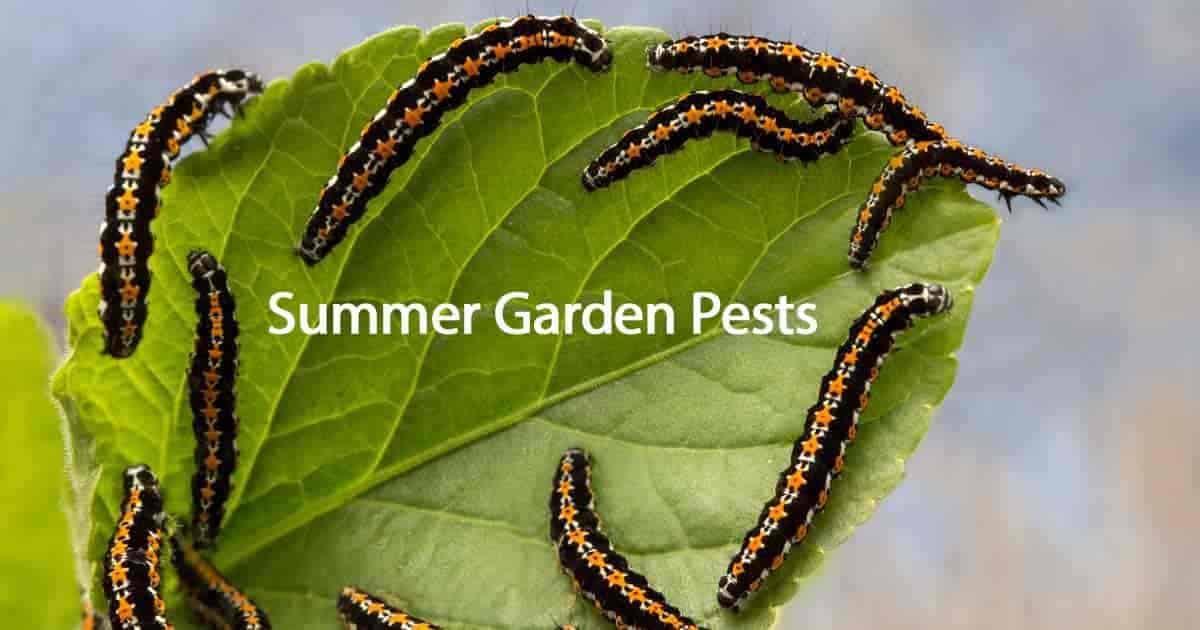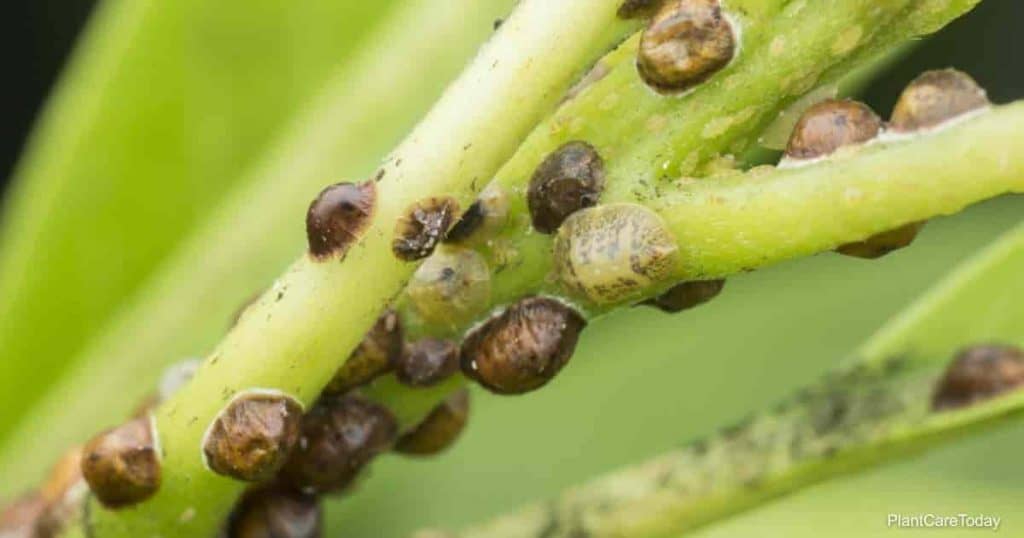Summer is a great time to work in the garden, enjoy the outdoors, and reap the benefits of your hard work. Unfortunately, many bothersome insects feel the same way, and you must contend with them.

Here, we’ll discuss some of the most active and pernicious common summer garden pests and their control measures.
The Top 11 Most Bothersome Summertime Pests
You’re sure to encounter at least one of these apex garden botherers each year. Hopefully, knowing this wide range of usual summer pests will help you stay on your toes about how to control them.
#1 – Aphids
Aphids are well-known plant destroyers that typically suck plant juices, causing leaf discoloration and stunted growth on your precious plants.
Appearance: Adult aphids can also be dark brown or reddish in color and about 1/16th of an inch. They have a pear-like shape, pointy heads, and small dark eyes.
Mitigation: The most common way to get rid of aphids is by introducing beneficial insects, such as lady beetles, lacewings, predatory stinkbugs, or praying mantises, especially into your vegetable garden.
You can also hose them down to knock them off the leaves. Or you can also make a homemade spray with a small concentration of dish soap which they are repulsed by. This will take regular treatments over a season.
#2 – Vine Weevils
Vine weevils don’t just eat the leaves but the roots as well. The damage they cause can surprise you if they focus on the roots, as the plant suddenly falls over without warning.
Appearance: These bugs are tough to spot. But watch out for the darkly colored adults with their yellow spotted abdomens. Affected plants will usually die in the late summer or fall. You may notice notch-like damage on leaves, which is pretty much the only warning sign they will give.
Mitigation: The predatory worm known as Steinernema kraussei may be the only way to attack these insects, except for certain harsh chemicals.
#3 – Japanese Beetles
Japanese beetles are pesky species of scarab beetles that damage various ornamental plants, deciduous trees, and shrubs. They often leave skeletonized leaves and the entire plant weakened.

In their immature stage, where they are called grubs, they commonly feast on grassroots, leaving dying brown lawns.
Appearance: They grow about 1/2″ inch long, with shiny bronze wings and metallic green bodies. They also have white, dot-like hair tufts along their sides and rear.
Mitigation: An excellent way to control Japanese beetles is to spray the affected plants with pyrethrin or neem. Imidacloprid, a systemic insecticide, can also be applied. Mechanical traps can also be used to attract and trap them. It can be bought in garden centers.
#4 – Codling Moths
These true moths are fond of feeding on fruits, making large rotten holes, and consuming the fruit from the inside. Their larvae are the most common type of worm you’ll find in apples.
Appearance: They are small, mottled grayish in color, and are most active at night. Because they are nocturnal, they are easy to miss. But their tracks and marks are distinctive.
Mitigation: Chemical insecticides and parasitic wasps are usually the best ways to deal with these invaders. Picking the fruits of your trees is a good way to attract fewer codling moths.
#5 – Scale Bugs
Plant Scale bugs leave nasty-looking scabs or scale-like growths on stems and branches, resulting in inhibited growth.

Appearance: They can be either hard or soft-shelled or clear or black. They also produce a mucose, sometimes called “honeydew.”
Mitigation: The best way to get rid of them is to prune away the affected parts of the plant. Lady beetles will also go after these guys and eat the larvae. Insecticidal soap is another good solution, but it will take several rounds to take effect.
#6 – Gall Mites
These mites are hard to miss. They make inflamed-looking growths on the surface of leaves. Although they look disgusting, they are relatively harmless to the plant. They only suck a small amount of sap, usually not enough to hinder growth.
Appearance: Long, pimple-looking protrusions. These are not the mites themselves, just the evidence of their reproductive cycles. But this is what you will see, not the actual mites.
Mitigation: Pinching off the affected leaves is usually the best option. There are no effective pesticides for these insects.
#7 – Thunder Beetles
Also known as Thrip beetles, these are small black bugs that create small white patches on the leaves of plants indoors and outdoors. The word “thrip” refers to a category of insect that encompasses over 6000 species.
Appearance: Adult beetles are small, black, long, and almost worm-like in how they move. Affected plants will become splotchy and pale before death.
Mitigation: The best way to deal with them is through the preventative clearing away of rotting organic matter from your garden area. Botanical pesticide is another good response once they have established a colony.
#8 – Winter Moths
An invasive winter insect, the Winter Moth will eat almost every plant it comes into contact with. They will damage trees and then drop down to eat anything they find below.
Appearance: They are small and grayish-brown with round wing tips. They produce silky web leavings under leaves, and leaves become arched or “tented” when affected.
Mitigation: Trees should get extra water during the growing season to help them recover from winter moth damage. Oil sprays work well to kill the eggs. Few biological remedies will work since they thrive during the winter.
#9 – Leaf Miners
Leaf miners are odd insect pests that do little damage to plants other than stunting their growth slightly and leaving strange-looking tracks.
Appearance: They are dark reddish with rectangular bodies and brownish spotting. If you don’t see the insects directly, you can identify them by the scribble-like tracks they leave, which are usually off-white in color.
Mitigation: If you can catch them early, you can remove the leaf miner larvae by removing the affected leaves. Simply look for the tracks and cut the leaves they appear on.
#10 – Whiteflies
Whiteflies are tiny troublemakers that suck plant sap in vegetable and ornamental plantings. They are resistant to a wide range of pesticides, making them tough to eliminate. They like to infest indoor spaces and are most common in the Southern and Northern US in the summer months.

Appearance: They are about 1/16th of an inch long and look like tiny moths. They appear on the leaves top side and the mature plants’ upper portions. Smaller ones will tend to gather on the underside of leaves.
Mitigation: Sticky traps are a good way to kill whiteflies. Beneficial insects like lady beetles and lacewings are also fond of hunting them. Another good solution is insecticidal soap, soapy water, or neem on leaves.
#11 – Red Spider Mites
Red spider mites are tiny common pests live beneath the top layer of leaves and drink the sap. They cause leaves to die and fall prematurely and are common in camellias, apple trees, and azaleas.
Appearance: These tiny, red creatures leave yellow spots on leaves and usually appear on the bottom side of leaves.
Mitigation: The best way to deal with them is to deploy predators like lacewings or ladybugs. The humidity of an indoor garden can dissuade them from remaining in the area, and insecticidal soap helps as well.